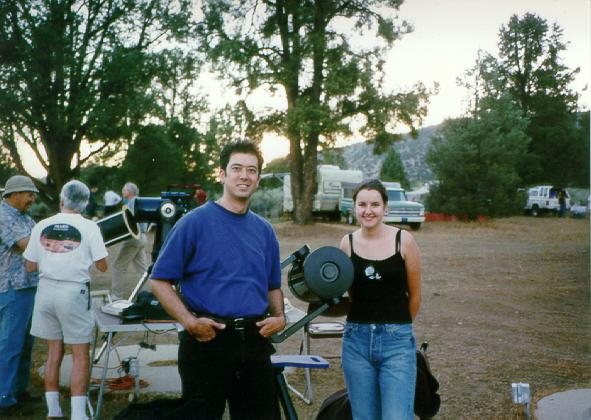
On Saturday night, July 5, 1997 I went to the Los Angeles Astronomical Society dark-sky site in Lockwood Valley for the monthly star party. I brought along my friend Jennifer. On the way there, I told her about my idea for the night: With a bit of luck, we could see all nine planets that night. Mercury would be difficult, as it was close to the Sun, and Pluto would be hard to identify, but it seemed like an interesting project for the evening. I also planned on bagging my last Messier object, as well as my "shopping list" of other things to try and see.
When we got there, there was already a good group set up and ready to go. As the sun went down, I took my binoculars over to a place where I could look through a gap in the trees and see Venus, which was about 20 degrees above the horizon at the time. From Venus, I scanned down 12 degrees and a bit to the north and just barely was able to make out the thinnest crescent moon I've ever seen. This was the necessary guidepost. Looking six degrees up and right from the moon revealed Mercury, standing just over the ridge of the mountains. Quite a few people were surprised that it was visible, and several stepped up to the binoculars for a look.
At this point, we had seen two planets. A quick look at the ground made it three. Earth was easy.
As the twilight faded, Mars came out, high in the west. A look in the telescope showed a very small disk. The seeing was not very good, so that was about it.
By now, it was fully dark, and it was time to try to see some other things before going back to the planet quest.
I managed to find the Cat Eye Nebula in Draco, nearly breaking my neck in the process. Objects close to Polaris are very hard to star-hop to with a fork-mounted Schmidt-Cassegrain telescope... Ow. Still, it was quite bright, as these things go.
At this time I heard some people at the next pad talking about the Veil Nebula. I'd never seen this and always heard that it was very hard to see. I went over for a look. They had a 12 inch or so Dob pointed at it, and it was obvious. It even showed some very pretty filamentary structure. I had to try it with my scope. I was able to find it pretty easily, but it didn't show any structure. Once again, Size Matters.
Now it was fully dark, so it was time for Pluto. We had brought along a pan of fresh-baked brownies with the intention of using them as a bribe for someone with a big telescope to help us find Pluto. We went over to Randy and his 10 inch LX-50, bringing the brownies and the finder chart from the May Sky and Telescope. After some careful star-hopping and looking through several different eyepieces, we all agreed that we were in the right field and that Pluto had to be one of two or three very faint stars in the field. We all made sketches of the field and a pact to examine the same field next month to see which star isn't there then. [This is the "half-a-planet" from the title.]
By this time, Jupiter was coming up over the trees. That meant that Uranus and Neptune were up. I was able to just barely see Uranus naked-eye. A look with the telescope showed a small blue disk. A short star-hop to the west got us to Neptune, which looked like an even smaller blue disk. I can see how planetary nebulae got their name.
At this point, we had bagged seven-and-a-half of the nine planets.
Now there was a lull for a time while we waited for Saturn to come up. We looked at Jupiter for a bit, but it was so bright that it kind of hurt. We also looked the Helix Nebula and the Blue Snowball. The Snowball [NGC 7662] was very bright and showed a hint of blue in my C-8.
By now, it was nearing 4:00 and I could see Saturn peeking up over the trees. That meant it was time for me to find M77 in Cetus and finish off my Messier list. A quick star-hop came to a little oval smudge. It didn't look like much, but it was the last object on my list.
A quick swing of the telescope brought us to Saturn and the end of the planet quest. We spent a while looking at Saturn and Jupiter, experimenting with different color filters and eyepieces. Still, the not-very-good seeing sort of ruined it. The Red Spot went down in my log as "suspected". By now, the glow of dawn was appearing in the east. We packed up everything and headed back down to the city.